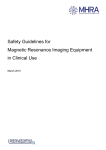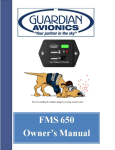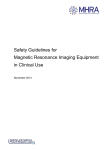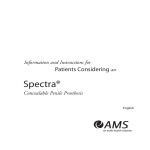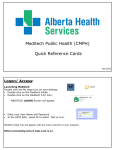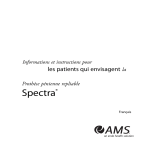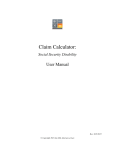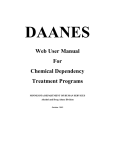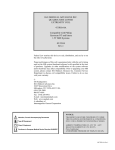Download MRI Safety Manual - Center for Translational Imaging
Transcript
Northwestern Memorial Hospital MRI Safety Manual Prepared by Todd Parrish, Ph.D. June 1999 Northwestern University – MR Research Safety Guidelines 1 Table of Contents 1. 2. MRI Safety Policies and Procedures: Overview 1.1 Goals and Objectives 1.2 Department Description Policies and Procedures: Environmental Safety 2.1 Magnetic Field Safety 2.2 Laser Light Safety 2.3 Electrical Safety 2.4 Cryogen Safety 2.5 Emergency Safety 2.6 2.7 3. 2.5a Magnet Stop button 2.5b Magnet Quench 2.5c Fire 2.5d Arrest Response/Resuscitation Healthcare Team Safety - Education/In-service Policy 2.6a Housekeeping and Maintenance 2.6b Anesthesia 2.6c Nursing Personnel 2.6d Staff Technologists 2.6e Scanner Maintenance Pregnancy Guidelines (Employees) Policies and Procedures: Patient Safety 3.1 Patient Screening 3.1a Scheduling Procedure and Form 3.1b Interview Forms 3.1c Technologist’s Interview/Screen 3.1d Metal and Foreign Body Policy Revised March, 2001 Northwestern University – MR Research Safety Guidelines 2 3.1e Biomedical Implants, Materials, and Devices 3.1f Electrically, Magnetically or Mechanically Active Devices 3.1g Miscellaneous devices 3.2 Pregnancy Policy (Patients) 3.3 Patient Weight Guidelines 3.4 Critical Care Patients 3.5 Pulse Oximeter Policies and Procedures 3.6 Sedation 3.7 EKG Lead Safety 3.8 Anesthesia Guidelines 3.9 Injection of Contrast Material 3.9a Obtaining Consent 3.9b Injection 3.9c Reaction to Contrast Material 3.9d MRI Contrast Material 3.10 Auditory Protection Guidelines 3.11 Radiofrequency Field Exposure 3.11a Heating due to Radiofrequency Excitation 3.11b Radiofrequency Antenna Effects 4. 3.12 Nerve Stimulation Guidelines 3.13 Cardiopulmonary Arrest 3.14 FDA Guidelines 3.15 IRB Regulations and Reporting Systems Safety Related MRI Forms 4.1 New patient intake sheet 4.2 Consent Form for Pregnancy 4.3 Sedation Questionnaire 4.4 Old Patient Questionnaire 4.5 Old Patient Medical History Screening Form Revised March, 2001 Northwestern University – MR Research Safety Guidelines 3 4.6 Old Patient Questionnaire in Spanish Revised March, 2001 Northwestern University – MR Research Safety Guidelines 4 1. MRI Safety Policies and Procedures: Overview 1.1 Goals and Objectives Northwestern Memorial Hospital is committed to insuring patients’ safety and to providing employees with a safe and healthy workplace. Work areas throughout the hospital are diverse, and safety standards need to be specific for each environment. The work environment and patient care provided in the MRI section are particularly unique. The powerful magnetic field generated by an MRI scanner presents many special safety concerns for both patients and employees. For this reason, specific guidelines have been established and are enforced to make the area safe for patients, employees and visitors. 1.2 Department Description The MRI section of the department of Radiology operates two high field (1.5 Tesla) Siemens Medical Systems Symphony clinical imaging systems on the 4th floor of the Feinberg Pavilion. There are 3 more bays, which can be used for future scanners. An outpatient facility located at 441 E. Ontario houses two more magnets, which are also 1.5 Tesla machines. One of these is a Siemens Vision system and the other is a Philips Gyroscan NT. Two research scanners (owned and operated by Siemens Medical Systems) are maintained on the Chicago campus. One is located adjacent to the outpatient facility and the other is in the basement of Olson. These magnets are Siemens Symphony 1.5T scanners. Some clinical research protocols are being conducted on these magnets, so clinical activities occurring in these facilities also need to follow these guidelines. All of the MR systems are equipped with active shielding, which uses a separate counter magnet to reduce the fringe magnetic field surrounding the magnet. However, extreme caution must still be maintained by anyone working in or around either system. Active shielding may give a false sense of security regarding protection from magnetic field effects because workers/patients are able to get much closer than one would expect. However, the presence of shielding dramatically increases the amplitude of the magnetic gradient. This steep gradient causes a much stronger force on objects as they approach the gantry. This makes for a dangerous situation because the worker may be lulled into a sense of no magnetic field until it is too late to stop the projectile. The goal of this manual is to document procedures to prevent this from happening and discuss what to do if it does happen. Revised March, 2001 Northwestern University – MR Research Safety Guidelines 5 2. Policies and Procedures: Environmental Safety 2.1 Magnetic Field Safety Off-Hours access to the MRI scanners The magnets in the Feinberg Pavilion have 24-hour access. The door to the MRI control room is locked with a numeric code mechanism. Only authorized personnel should have access to this code. During off-hours (11pm-6:30am) and weekends after 4pm, the doors that allow access to the outpatient MRI facility are locked. Only those authorized should have key access. The research scanners both have key access for authorized users only. Security Zone The Security Zone is defined as the area within the walls of the scan room where the MRI magnet is located. The magnetic field in the Security Zone (magnet room) is strong enough to attract ferromagnetic objects with great force. Ferromagnetic objects that are brought close to the bore of the magnet therefore have the potential to become projectiles. Such objects may cause serious injury to a patient or staff member. Therefore, it is mandatory for the scanner operator to limit access to and screen all individuals entering this area. Screening All persons entering the Security Zone shall be properly screened with no exceptions. No one will be allowed to enter this zone until appropriately checked and questioned regarding items or devices which may prove hazardous to their safety or that of others. The operator (technologist) is responsible for the proper screening of anyone who is allowed to enter the Security Zone. Criteria for screening are outlined under Section 3.1 of this manual. Fringe Field Area The Fringe Field Area, which is contained in the Security Zone, is defined as the area where the magnet field strength exceeds five gauss (or 5 milli-Tesla). The stray magnetic field, outside the magnet bore, has no respect for the confines of conventional walls, floors or ceilings. The fringe field area is a 3D space. Cardiac pacemakers, neurostimulators or similar devices may malfunction in an environment of greater than 5 gauss, and people with such devices must not be allowed to enter the Revised March, 2001 Northwestern University – MR Research Safety Guidelines 6 Fringe Field Area (see section 3). Warning signs must be posted at doors leading to any area where the magnetic field strength is 5 gauss or greater. 2.2 Laser Light Safety The laser light localizer at the magnet bore facilitates correct patient positioning. The localizer consists of several laser light sources (class II). The Symphony and the Vision use this system for localizing the region of interest in the patient. The eyelid’s natural winking reflex to light usually provides sufficient protection for the eye. However, this reflex may be lost or impaired due to general anesthesia or illness. In such cases, patients should be asked to wear the supplied protective glasses. The patient should be instructed to close their eyes when the laser light is being used to localize anatomy. The laser light should be switched off immediately once the patient is positioned. In case the laser light localizer is not used within one minute after it is switched on, it will automatically turn off by itself. Service personnel check the light at regular intervals. Do not perform any examination if the laser exits as a spot beam rather than in the form of cross hairs; contact service immediately. 2.3 Electrical Safety In the case of an electrical emergency, use the emergency shutdown buttons located in the computer room near the main console, and in the magnet room. This button will immediately shutoff all power to the system. Note that the magnetic field is not changed. The following guidelines for electrical safety should be followed. Additional information can be found in the Siemens User manual entitled "System Guide". 1) The MR scanners should be operated in compliance with all relevant legislation and recommendations concerning electrical safety in rooms used for medical purposes, e.g. US National Code, VDE, or IEC Standards concerning provision for an additional protective earth ground. 2) The system hardware and software prevents operation above specified (i.e. power, current, heat, etc.) levels, as mandated by the FDA and monitored by the manufacturer. 3) Only authorized service personnel should be allowed to replace or repair any component in Revised March, 2001 Northwestern University – MR Research Safety Guidelines 7 the system. Special non-ferrous tools may be required. 4) All covers and doors of electronic equipment shall remain closed, and only authorized service personnel are allowed to open them. 5) The equipment is not suitable for use in the presence of flammable gases or vapors. 6) Some disinfectants vaporize, forming potentially explosive mixtures; if such disinfectants are used, the vapor must be allowed to disperse before the equipment is returned to use. 7) Do not allow water or other liquids to enter the equipment, as they may cause short circuits or corrosion. 2.4 Cryogen Safety Superconducting MRI magnets use liquid helium with or without liquid nitrogen to cool wires that carry current to produce the magnetic field. These liquids (cryogens) are several hundred degrees below zero, 4K (Kelvin). Accidental contact may cause frostbite. The cryogens can also boil off and pose a risk of asphyxiation; vaporizing cryogens can displace oxygen and cause loss of consciousness in as little as 5-10 seconds. Cryogens come in large vacuum containers called “Dewars.” If clouds of gas are seen coming out of a Dewar or a liquid spills or leaks from a Dewar, evacuate the area as quickly as possible. Do NOT tamper with any of the valves on the Dewar. Do NOT attempt to clean up a spill from a Dewar, and do NOT step in the spilled liquid. The liquid is extremely cold (4K) and may cause frostbite. The following information is from Liquid Cryogens, Volume 1. Theory and Equipment, edited by K. W. Williamson and F. J. Edeskuty, CRC Press, Boca Raton, FL 1983: “Spills and leaks of cryogenic liquids and vapors, except for oxygen, will cause an oxygen-deficient environment in which exposed personnel could suffer extreme damage. Asphyxia develops slowly as the oxygen content of the air is reduced from 21%. The victim will probably not be aware of the problem, since the symptoms of gradual asphyxia are difficult to recognize. Also, the symptoms will vary with the individual’s physical condition and activity within the changing atmosphere. Four stages of gradual asphyxia have been noted: (1) With the oxygen constant in the air reduced from 21 to 14% by volume, the initial signs of anoxemia are increased breathing volume and accelerated pulse rate. The worker’s ability to maintain attention, diagnose the situation, and think clearly is diminished. Muscular coordination also decreases. (2) In oxygen concentrations reduced from 14 to 10% by volume, consciousness continues but judgment becomes faulty, there is a loss of coordination, increased errors in judgment, and increased symptoms of sleepiness and fatigue masked by a state of Revised March, 2001 Northwestern University – MR Research Safety Guidelines 8 euphoria. (3) Oxygen concentrations reduced to 6% by volume cause nausea and vomiting. The victim completely loses the ability to perform any muscular movements and is not aware that anything is wrong. His legs give way, leaving him unable to walk, stand, or even crawl. This is often the first and only warning he gets. At this stage, the victim probably has suffered permanent brain damage. (4) With oxygen concentration reduced below 6%, respiration comes in deep gasps and convulsions occur. The breathing stops, but the heart may continue beating for a few minutes. Exposure to such low oxygen concentrations for about 8 minutes would be 100% fatal; for 6 minutes, approximately 50% fatal. Asphyxia may also occur suddenly. Acute asphyxia, such as from breathing pure inert gases, produces immediate unconsciousness without warning and so quickly that the individual cannot help or protect himself. The worker may fall as if struck down by a blow to the head and will die within a few minutes if not resuscitated.” Staff members (radiologists, technologists, assistants, nurses and security, service and custodial personnel) should be aware of cryogen risks and know what procedures to follow in the event that an oxygen monitor (Feinberg Pavilion only) indicates low oxygen concentration. These risks and procedures should be included in the inservice educational presentations discussed in Section 2.6. 2.5 Emergency Safety 2.5a Magnet Stop Button or Emergency Run Down Button The environment surrounding a powerful magnet presents the potential for an accident, possibly causing serious injury to a patient or employee. There are no obvious signs that the magnet is ON so caution should be used at all times. If such an accident occurs, the force of the magnetic field may hamper prompt response and assistance. It may then be necessary to remove the magnetic field, which should only be done if there is no other recourse. A fire in the MRI site may be another situation in which quick removal of the magnetic field may be required for prompt response. The MAGNET STOP button may be used to remove the magnetic field. The MAGNET STOP button reduces the magnetic field strength to a low value as quickly as possible. The static magnetic field will ramp down from 1.5T to less than 20 mT in less than 20 seconds. One MAGNET STOP button is located in the control room on the system power control. Another is located in the magnet room. During the magnet stop process, the magnetic field energy is transferred to the cryogens as Revised March, 2001 Northwestern University – MR Research Safety Guidelines 9 thermal energy. As a result, the cryogens boil off rapidly and are vented to the outside. A loud noise (like a train) will be heard as the liquid boils off and changes to a gas (1 liter of liquid goes to >200 liters of gas). Inadequate venting could reduce the oxygen level in the scan room and cause a risk of asphyxia (see 2.4). Service should be called immediately after pressing the MAGNET STOP button or after any magnet quench (see 2.5b). This will reduce the potential damage to the magnet. 2.5b Magnet Quench The “quench” of a magnet refers to the rapid loss of the static magnetic field. This is what happens when the MAGNET STOP button is pushed or it can happen spontaneously. A magnet quench will usually result in a loud boom or may be followed by a loud hissing sound. Quenches are caused by escalating reactions to heat, which cause the cryogens to boil off very rapidly. The magnet windings are no longer superconducting and heat up, causing vaporization of the cryogens (liquid helium/nitrogen). These gases are vented directly to the outside air. It is important to know that oxygen in the scan room can be displaced quickly if cryogen venting is inadequate. User-invoked Quench. An invoked (i.e. intentional use of the MAGNET STOP button) quench of a magnet should only be executed in the case of an extreme emergency (such as a person being pinned between the magnet or a ferromagnetic object which cannot be removed without risking injury). In such a case, the magnetic field should be promptly removed by pressing the MAGNET STOP button. Remove the patient from the magnet room immediately. Contact the monitoring radiologist and appropriate MRI service personnel as soon as possible. Please note the following points about quenching a magnet: 1) Quenching may cause oxygen deprivation in the magnet room if the cryogen evacuation vent malfunctions. 2) The rapid warming of the superconducting wire may damage the wire and thus damage the magnet itself. 3) Quenching is very costly due to the expense of the cryogens, ~$20-40,000. Spontaneous Quench. It is possible, but highly unlikely, that a spontaneous quench of a magnet could occur. In such a situation, the system is designed to behave as though someone pushed the Magnet Stop button. If a spontaneous quench occurs, remove the patient immediately, following the same procedure as a user-induced quench. 2.5c Fire General. There are three basic steps that must be taken if a fire is discovered. 1) Protect those Revised March, 2001 Northwestern University – MR Research Safety Guidelines 10 immediately affected by the fire and smoke. 2) Confine the fire and smoke by closing doors that will isolate fire/smoke to a given room or area. 3) Notify those responsible for responding to the fire scene by: (a) pulling the nearest/safest fire alarm pull station; (b) calling the hospital operator and reporting the exact location of the fire. Response to a Fire in the Magnet Room. 1) Disconnect electrical power to the MRI system by pressing the emergency SHUTDOWN button. 2) Use only non-magnetic fire extinguishers. 3) If the fire is not extinguished after emptying the available extinguisher, or jeopardizes the safety of personnel, the magnetic field must be removed by pressing the MAGNET STOP button on the Emergency Rundown Unit. 4) All personnel, including firefighters, must be screened for entry into the restricted magnetic field area before the magnetic field is removed. Response to a Fire in the Computer Room. 1) Disconnect electrical power by pressing the emergency power “off” button also called the emergency SHUTDOWN button. 2) Use only a HALON fire extinguisher inside the computer room. 2.5d Arrest Response/Resuscitation (see also Section 3.14) In the event of a respiratory or cardiac arrest of a patient during an MRI examination, it is essential to provide prompt medical care to the patient, insure the safety of all responding personnel, and to protect the scanner. 1) A call to the hospital emergency operator will be made immediately upon identification of respiratory or cardiac arrest. 2) Any radiology personnel in the immediate area should be summoned to provide assistance. 3) The technologist and/or radiology personnel should remove the patient immediately from the magnet room (non-magnetic gurney/table) to an adjoining room appropriate for resuscitation. 4) The remainder of the code will follow standard hospital policy. 2.6 Healthcare Team Safety Education/Inservice Policy All hospital personnel who contribute to the operation and maintenance of the MRI Department must be properly educated about safety issues associated with this technology. The following policies and regular inservices are provided to ensure the safety of patients and employees when ancillary personnel assist or work in the MRI Center. Revised March, 2001 Northwestern University – MR Research Safety Guidelines 11 2.6a Housekeeping and Maintenance Housekeeping and Maintenance workers attend documented annual safety inservice reviews for their departments. The safety review is conducted and scheduled by the MRI Supervisor and with the department head. All employees assisting in MRI are required to review the MRI safety videotape prior to working in the MRI center. MRI Center may be cleaned and maintained according to normal hospital procedures, except for the magnet rooms. 1) No person shall enter the magnet room without proper training 2) The cleaning/maintenance person will be asked to remove jewelry, hairpins, and all loose objects in their pockets. 3) The cleaning/maintenance person should be made fully aware of the danger of taking any metal object into the room, stressing that the magnet is “on” at all times. 4) Only all plastic cleaning equipment can be taken into the scan room. 5) The cleaning of the magnet itself (interior and table area) is the responsibility of the technologists and should not be attempted by housekeeping staff. 2.6b Anesthesia Safety inservices will be provided annually for the anesthesia department personnel assisting with procedures in the MRI section. Safety inservices include the viewing of an MRI safety videotape, a review of any incidents and verbal communication. 1) All patients to be anesthetized and all anesthesia personnel must be properly screened before entering the MRI scan room. 2) No ferromagnetic objects can be brought into the magnet room. 3) Patients will be prepped in accordance with established anesthesia guidelines. 4) The In Vivo monitoring system will be used for all anesthesia cases and monitoring options (EKG, end-tidal CO2, oxygen saturation level, blood pressure, etc.). 5) Any incidents will be reported to the Safety Committee of the hospital and to the Anesthesia Department for review of the incidents, and experience in the department will be documented. 2.6c Nursing Personnel Annual safety inservices are provided to the radiology nursing staff by the MRI supervisor. This includes viewing of the MRI Safety videotape. Documentation of this meeting is kept in department records. Revised March, 2001 Northwestern University – MR Research Safety Guidelines 12 2.6d Staff Technologists Monthly department meetings are held to update staff members on operations of the MRI Center. If safety issues have arisen, the meeting is used to educate staff members about the issues. Educational inservices are periodically provided to the staff regarding new capabilities of the MRI systems. If there are safety considerations related to new developments, the issues are addressed. Documentation regarding the focus of the educational inservices is kept on file. 2.6e Scanner Maintenance Maintenance of the MRI scanner is to be performed only by contracted service personnel who are familiar with the hazards of the MRI environment. Technologists working in MRI must follow any operational guidelines set by the vendor providing maintenance service and the equipment manufacturer. Routine preventative maintenance is currently scheduled once per month on each scanner. Quality assurance scans are performed every morning to assess function and performance of the equipment. 2.7 Pregnancy Guidelines (Employees) There are currently no established regulatory guidelines for occupational exposure of pregnant women to magnetic resonance imaging systems. A survey of female MR operators by Kanal et al did not find a substantial increase in common adverse reproductive outcomes. (Kanal E, Gillen J, Evans J, Savitz D, Shellock FG. Survey of reproductive health among female MR workers. Radiology 187: 395-399, 1993). However, the following policies have been established on a precautionary basis: (1) All employees in the MRI area must report their pregnancy to the supervisor of the area as soon as it is known. (2) The pregnant employee may continue all duties required of their position, with the exception of occupying the magnet room during the acquisition of images. 3. Policies and Procedures: Patient Safety 3.1 Patient Screening Revised March, 2001 Northwestern University – MR Research Safety Guidelines 13 Several separate screening procedures are used to insure that a patient may safely undergo an MRI examination (or that accompanying individuals may safely enter the scan room). Using these procedures, the MRI technologist will determine whether it is safe for the patient or other individuals to enter the magnet room. If the technologist has questions about patient safety, a radiologist should be consulted. 3.1a Scheduling Procedure and Form MRI personnel schedule all patients for an MRI study. At the time of scheduling, a brief review of the patient’s medical history, given by the ordering physician is performed to insure MRI suitability and protocol issues (See forms in section 4). In addition, the scheduling personnel determine that the patient is medically stable and competent to sign consent forms (or that appropriate consent has been obtained). 3.1b Interview Forms The patient (or guardian) completes two screening forms at the time of registration in the MRI Center prior to undergoing the scan. Currently, these forms have been combined into a single sheet (see section 4). The patient will also be given any necessary consent forms, if required. 3.1c Technologist’s Interview Prior to escorting the patient into the scan room, the technologist verifies that all MRI forms have been completed and signed by the patient or guardian. The medical history is carefully reviewed by the technologist prior to the procedure. If questions regarding suitability are raised, they are addressed with a radiologist before the MRI study begins. 3.1d Metal and Foreign Body Policy Any patient with a history of metallic foreign body in the eye or body (e.g. from work injury, accident, or gunshot wound) should be screened to insure safety. (1) A history should be obtained regarding the nature and timing of the incident and the type of foreign body or injury. (2) Patients with a history of metal in the eye or a history of possible exposure (i.e. metal work without proper protection) will normally undergo orbital x-rays to check for a residual metallic foreign body. A Revised March, 2001 Northwestern University – MR Research Safety Guidelines 14 radiologist will review the x-rays to determine if the patient may be safely scanned. (3) In special situations or when orbital x-rays are inconclusive, a non-contrast CT scan of the orbits will be performed at the discretion of the radiologist to further assess the possible presence of a metallic foreign body. 3.1e Biomedical Implants, Materials and Devices MR procedures may be contraindicated for patients with the following devices due to risk of movement, dislodgment, heating or induced electrical currents. For approval of the MR procedure, the attending radiologist must verify that the particular device (manufacturer and model) has been previously tested by checking in the latest version of Magnetic Resonance: Bioeffects, Safety, and Patient Management or searching the web site maintained by the same authors at www.MRIsafety.com. Any patient with a known device or implant of the following type needs the item approved by the radiologist prior to gaining entry to the magnet room. Special consideration needs to be given for the location of the device relative to the imaging region of interest. The following items require additional investigation: aneurysm and hemostatic clips, biopsy needles, breast tissue expanders and implants, carotid artery and other vascular clips and clamps, dental implants, halo vests and cervical fixation devices, heart valve prostheses, intravascular coils, filters and stents, ocular implants, orthopedic implants, otologic implants, cardiac occluders, pellets and bullets, penile implants, vascular ports and catheters, pumps and drug delivery systems, shunts, and contraceptive devices. This list is not exhaustive. The philosophy should be maintained that nothing is allowed in the magnet room unless it has been previously approved by the radiologist, with the assistance (if necessary) of the Shellock book or the Kanal web site. 3.1f Electrically, Magnetically or Mechanically Activated Devices Patients with the following devices should not undergo an MR examination for reasons described in section 3.1e. In the case of a medical emergency, the exam must be approved by an attending radiologist. The radiologist must verify the MR compatibility of the device and determine that the type of MR exam is medically necessary. Revised March, 2001 Northwestern University – MR Research Safety Guidelines 15 3.1g Miscellaneous devices Any device or implant not covered by the last two sections must be approved by the radiologist. This may require testing prior to its use in the magnet. Therefore, adequate notification time is required to conduct such tests. If an item is approved it should be added to a list of approved devices. This list should be located at the scheduling desk, nurse's station and the reading room. 3.2 Pregnancy Policy (Patients) There is no known fetal risk from MRI scanning during pregnancy, however, the absolute safety has not yet been established. (Magnetic Resonance: Bioeffects, Safety, and Patient Management by F.G. Shellock and E. Kanal). Therefore, the MRI section follows a conservative policy in this regard. All female patients of childbearing age will be questioned as to their last menses prior to having an MRI scan. Any patient who is pregnant or states that there is a possibility of being pregnant will not be scanned without the express approval of the supervising radiologist. The ordering physician must discuss with the MRI radiologist the need for MRI scanning of any pregnant patient. Particular caution should be exercised during the first trimester. In general, scans of pregnant patients should be deferred as long as possible. The use of contrast will be also be treated in a conservative manor and must be approved by the monitoring radiologist. 3.3 Patient Weight Guidelines The weight of patients must be considered in order to provide a safe imaging environment and to insure proper equipment function. • Weight up to 160 kg or 350 lb.: all table functions are operational. • Weight up to 200 kg or 440 lb.: table functions are limited, but there are no electrical or mechanical malfunctions. When large patients are placed into the magnet, extra caution is necessary to prevent injury to the patient, the technologist and damage to the equipment. Follow all patient-positioning guidelines. Warning labels on the magnet identifies potential points of injury and damage. 3.4 Critical Care Patients Patients with increased risk of cardiac arrest, seizure or claustrophobia, and patients who are Revised March, 2001 Northwestern University – MR Research Safety Guidelines 16 unconscious or seriously ill, may be scanned provided that close monitoring is maintained while the patient is in the magnet. In such cases, critical care nursing personnel may accompany the patient during the scan. All personnel entering the scan room will be properly screened to insure safety. Only MRI compatible monitoring equipment will be used. Fully functional “In Vivo” monitoring systems are available in both scan rooms. 3.5 Pulse Oximeter Policies and Procedures A pulse oximeter will be used for monitoring all sedation cases. A pulse oximeter will also be used at the discretion of the nurse or radiologist for any patient whose condition may warrant such monitoring. 1) Use the “In Vivo" monitoring system in each scan room. 2) Select the appropriate oximeter probe. a. Pediatric b. Adult 3) Secure the oximeter probe to a finger or toe, as far as possible from the area being scanned. 4) Assess accuracy of heart rate to assure accuracy in oxygen saturation reading. 5) Closely observe the patient and the oximeter readings during the procedure. 6) After use of the oximeter, return it to the appropriate storage area and plug it into the wall socket to charge the battery for future use. What to do when there is a drop in Oxygen Saturation below 90%: 1) Assess the patient’s... (1) Respiratory Rate (2) Head/Neck Position (3) Airway (4) Color 2) Check the oximeter probe. (1) Loose Probe (2) Loose Cable (3) Incorrect Placement Revised March, 2001 Northwestern University – MR Research Safety Guidelines 17 3) Check the oximeter. (1) Low Battery (2) Malfunction 4) Initiate supplemental oxygen at 3-5L/min per nasal cannula. 5) Maintain airway alignment. 6) Assess need for further assistance and call for help if needed. 3.6 Sedation To provide maximum safety and comfort for adult patients with claustrophobia, pain or other medical conditions that make it difficult for the patient to tolerate or cooperate during the MRI study, the following responsibilities and procedures have been established: Responsibilities Attending Physician, Radiologist Procedures 1. Evaluate the patient to determine the need for sedation. or Radiology Nurse Scheduling Secretary 1. Schedule the patient in an appropriate sedation time slot. 2. Notify the office scheduling the exam to inform the patient that he/she will not be able to drive for 4 hours after the sedation, so that a responsible adult can accompany the patient. 3. Refer questions about sedation to a radiology nurse. Radiology Nurse 1. Obtain a medication order form from the supervising physician or use adult sedation standing orders. 2. Interview the patient for pertinent information including any allergies or recent illness. 3. Administer medication as ordered; notify the supervising MRI radiologist that sedation is beginning. 4. Monitor patients receiving sedation. Revised March, 2001 Northwestern University – MR Research Safety Guidelines 18 a. Pre- and post-sedation vital signs b. Use an oximeter to monitor pulse and oxygen saturation; record every 10 minutes. 5. After the scan, evaluate the patient and discharge when discharge criteria are met: a. The patient is able to ambulate without help. b. The patient tolerates oral fluids. c. The patient has a responsible adult to accompany him/her home. d. At least one hour has elapsed since the last dose of sedation. e. Notify the supervising MRI radiologist that the patient is being discharged. General Policies and Procedures: A. IV sedation should be used cautiously in elderly patients, patients who have chronic hypertension and patients with respiratory depression or hepatic or renal insufficiency. B. Interview the patient for pertinent medical history. Take pre-sedation vital signs and document the information on the sedation form. C. Inform the patient that he/she will need to stay a minimum of 1 hour after the last dose of medication is given. Inform the patient that he/she should not drive for at least 4 hours after sedation. D. Inform the radiologist of the need for sedation. Confirm the availability of the radiologist for supervision of sedation during the scan. E. Start an IV of D5W or normal saline to infuse at TKO rate throughout the procedure. F. Monitor the patient with a pulse oximeter and/or an ECG monitor throughout the procedure (see Section 3.5). 1. The Radiology nurse will be the primary person to observe the adult patient under sedation. A nurse will observe the patient for at least the first 15 minutes after the last dose of sedation Revised March, 2001 Northwestern University – MR Research Safety Guidelines 19 has been given. After that time, an MRI technologist may observe the adult patient, if the nurse needs to assist with another patient. 2. If the O2 saturation falls below 90% or if the heart rate falls below 60 or is greater than 100, the MRI technologist must inform the nurse and/or the radiologist immediately. Standing Sedation Orders I. Anxiolytic Medications: A. Versed (IV) 1. Titrate Versed 1-2 mg IV slowly, dependent on the patient’s response. Total dose not to exceed 5 mg in a 20-minute period. 2. In patients over the age of 60, Versed should be titrated in 1/2 mg doses. B. Valium (PO) 1. Give Valium 5 mg PO. May give an additional 5 mg 1/2 hour later, if needed. C. Valium (IV) 1. Give Valium 2-5 mg IV slowly, dependent on patient’s response. Total dose not to exceed 10 mg. D. Ativan (PO) 1. E. Ativan (IV) 1. II. Give Ativan 1-2 mg PO 30 minutes before scheduled scan time. Titrate Ativan in 1-2 mg increments IV slowly. Total dose not to exceed 4 mg. Analgesic Medications: A. Fentanyl/Versed combination (IV) 1. Titrate Fentanyl 1/2 to 2 cc (50 mcg/cc), and Versed 1/2 to 2 mg, dependent on patient’s response. B. Demerol (IM) 1. Give Demerol 50-100 mg IM depending on patient’s medical history, age and weight. C. Demerol (IV) 1. Titrate Demerol in 12.5 mg increments. Total dose not to exceed 50mg. Revised March, 2001 Northwestern University – MR Research Safety Guidelines 20 3.7 EKG Lead Safety EKG leads are required for special types of imaging and for physiologic monitoring of some patients. Only MRI compatible leads can be used. These may be supplied by the vendor or be part of an MRI monitoring system (e.g. in vivo). 3.8 Anesthesia Guidelines Pre-anesthesia requirements 1. Written history and physical exam 2. Hemoglobin and hematocrit (done within 72 hours). A preoperative hemoglobin level is required for these patients: a. Patients with a history of anemia or other hematologic disorders b. Oncology patients c. Ex-premies <6 months of age d. Patients undergoing intra-abdominal, intra-thoracic, or neurosurgical procedures e. Tonsillectomy and adenoidectomy f. Patient’s returning for repetitive surgery associated with blood loss; e.g.: staged excision of nevi or repeat plastic/reconstructive surgeries 3. Vital signs available 4. All patients will be seen by a physician from the Department of Anesthesiology prior to the induction of anesthesia. A pre-anesthetic note including assignment of physical status clarification will be placed in the patient’s chart. 3.9 Injection of Contrast Material 3.9a Obtaining Consent - if required Responsibilities Radiology Nurse or Technologist Procedures 1. The consent form will be presented to the patient or patient’s legal guardian by a Radiology nurse or technologist who will render any assistance necessary to understand the form. The form must be read and signed Revised March, 2001 Northwestern University – MR Research Safety Guidelines 21 by the patient or guardian before the administration of intravenous contrast. If the patient wishes, a radiologist will be asked to counsel him/her before signing. Radiologist 1. Counsel patient or guardian regarding the use of intravenous contrast when needed. 2. When consent cannot be obtained because the patient is incompetent and family is not available, the decision whether to give contrast will be made by the radiologist monitoring the procedure and/or the referring physician based on medical judgment regarding the benefit vs. risk. When the decision to give contrast is made under these circumstances, this should be documented in writing by the responsible radiologist and/or referring physician (in progress notes or on the contrast interview form), indicating why consent could not be obtained and why it was necessary to administer contrast. 3.9b Injection Responsibilities Radiology Nurse Procedures 1. Shall be certified in IV insertion and drug administration. 2. Contrast injected into an existing IV line must be approved by an MD or RN. 3. Contrast should not be mixed with sodium bicarbonate, multivitamins or Dilantin. 4. Technologists may administer contrast through the power injector, if the appropriate line is used. 5. If a heparin lock is used, flush per hospital policy with normal saline. 6. Establish an IV using a 22 gauge or appropriate size catheter. Attach a normal saline flush system to the needle or Revised March, 2001 Northwestern University – MR Research Safety Guidelines 22 catheter using a syringe or intravenous bag of solution (50 ml-250 ml). Choice of technique depends on scan type and length of time before injection. 7. Draw up contrast media in a 20 ml syringe, with dosage based on body weight (consult chart). Protect solution from light. 8. Inject solution at appropriate time during the scan, typically the injection should occur over a 1 minute period. Flush IV with at least 10 ml of normal saline solution. 9. If no complication, IV may be discontinued and patient discharged 30 minutes after injection. 10. Document injection of enhancement material on interview form. Radiologist 1. The radiologist monitoring the examination must be immediately available in the Radiology Department during and for at least 10 minutes following the injection of contrast material. If the radiologist responsible for the procedure cannot be immediately available, he/she must arrange for coverage by another M.D. No injection of contrast will be performed without such coverage. 3.9c Reaction to Contrast Material Responsibilities Radiology Nurse or Radiologic Technologist Procedures 1. If an allergic reaction occurs, follow procedure as outlined in the Radiology Department procedure manual. 2. Place a PREVIOUS REACTION TO CONTRAST MEDIA sticker on the front of the patient’s x-ray jacket and on the front of the request for the examination. Indicate on the sticker the date of the reaction and the Revised March, 2001 Northwestern University – MR Research Safety Guidelines 23 symptoms of the reaction. 3. Document the type of reaction and treatment on the request and in the “Patient Reaction Log.” 4. Contrast Reaction -- allergy information sheets for patients are available at the nurses’ desk. Radiologist Supervising the Procedure 1. Document the type of reaction and treatment in the dictated report. If the reaction is severe, the radiologist should also document the occurrence on a progress sheet. 3.9d MRI Contrast Materials Intravenous contrast agents are indicated in MRI of adults and children (2 years of age and older) to provide contrast enhancement of lesions with abnormal vascularity or those thought to cause an abnormality in the blood-brain barrier. The contrast agent is often used to improve the visualization of vessels. Administration of these agents will be performed according to the recommendations and directions of the manufacturer as documented in the package inserts. 3.10 Auditory Protection Guidelines The primary source of the acoustic noise in the MRI system is from the changing magnetic field. The rapid switching of the current used to generate the gradient field causes strong forces to act on the gradient coil. It behaves much like an acoustic speaker. Federal guidelines have been established by monitoring the noise levels produced by MR systems. The limit value of 99 dB according to the OSHA standard is not to be exceeded without adequate hearing protection. Auditory protection (ear plugs) must be provided or offered to all patients undergoing an MRI examination, since the noise created by the gradient hardware can reach levels of concern for hearing injury. It has been determined that earplugs reduce noise by 10 to 30 dB and headphones reduce noise by 30dB, which is a sufficient amount of sound protection for the MR environment. The most significant factor determining the effect of noise levels on hearing is the actual duration of exposure of the noise. Although specific techniques such as EPI (Echo Planar Imaging) exceed the 99-dB level, the exposure is brief such that the risk may be minimized. This may not be true Revised March, 2001 Northwestern University – MR Research Safety Guidelines 24 for prolonged imaging or fMRI studies. 3.11 Radiofrequency Field Exposure 3.11a Heating due to Radiofrequency Excitation The Radiofrequency (RF) excitation pulses used in magnetic resonance imaging result in power absorption by tissue, with dose a function of frequency. As the field strength of the magnet is increased the frequency increases and hence so does the amount of RF heating. Under certain conditions, this may cause significant tissue heating. The amount of heating is dependent upon several factors such as patient size, patient location in the coil, coil type used for excitation, vascular integrity in the region of interest (radiator effect to remove heat) and pulse sequence timing. Prior to initiation of each scan, the level of heating is estimated by the MR system's computer and compared to the pre-determined exposure limits. If the proposed scan would exceed these limits, the operator is required to modify scan parameters, such as repetition rate, before the system will begin the scan. The estimate is based in part on patient weight; therefore, care must be taken to make sure weights are entered correctly to prevent excessive RF exposure. The Specific Absorption Rate (SAR), which quantifies RF exposure on an MR system, is normally limited to 1.5 W/Kg for the whole body, with a local SAR limit of 8.0 W/Kg. The MRI system does allow a higher level of operation (at 3.0 W/Kg whole body) while maintaining the same maximum local SAR level at 8.0 W/Kg. The upper level of RF exposure limits may be selected ONLY if the patient: 1. does not have compromised cardiovascular function or thermo-regulatory capacity. 2. does not have increased sensitivity to raised body temperature (e.g. fever). 3. is able to communicate via the squeeze bulb should they need assistance during the scan. 3.11b Radiofrequency Antenna Effects Radiofrequency fields can be responsible for burn hazards due to electrical currents induced in conductive loops. These loops can take the form of EKG leads; surface coils or even the body itself (clasping ones hands together for instance). Care must be taken by the technologist to insure that no conductive loops are present during the scanning of a patient. Revised March, 2001 Northwestern University – MR Research Safety Guidelines 25 3.12 Nerve Stimulation Guidelines Advanced techniques such as Echo Planar Imaging (EPI) require powerful gradients with very short rise times. Echo readout in such sequences is accomplished very quickly with rapid switching of strong readout gradients. The fast switching of strong gradients has the potential to cause peripheral nerve stimulation in patients. The body is especially sensitive to acquisitions in which the readout (frequency encoding) gradient is in the Y direction (i.e. sagittal scans or transverse scans with swapped phase/freq encoding). Stimulation is less likely in slimmer patients. The threshold at which peripheral nerve stimulation occurs is an order of magnitude lower than that required for cardiac stimulation. There is special software (Stimulation Monitor) which monitors the induced current from the changing magnetic field (dB/dt) for all sequences. The FDA does limit this level to 6T/sec; however, nerve stimulation is possible at levels less than this. The stimulation monitor informs the operator when a level is received where stimulation is possible. If this happens, the patient should be informed and carefully monitored. No EPI sequence should be run if the patient is making an anatomical loop with their body position; the likelihood for stimulation is increased if arms or legs are crossed. If nerve stimulation does occur, this must be documented and reported to the manufacturer (sequence information and specific parameters). A hospital incident report should also be completed. 3.14 Cardiopulmonary Arrest Due to the high magnetic field surrounding an MRI scanner, it is not possible to provide Advanced Cardiac Life Support to a patient who has arrested within the magnet room. Therefore, Basic Life Support will be started in the scan room, and the patient will be transported immediately to the Emergency Department where ACLS can be provided according to standard hospital policy. MRI personnel will activate the Code Blue button which goes off in the Emergency Department (E.D.). The patient will be transported immediately to the E.D. The following steps will be taken to accomplish this in a safe manner: EMERGENCY PROCEDURES FOR CARDIAC AND/OR RESPIRATORY ARREST IN THE MRI FACILITY. Revised March, 2001 Northwestern University – MR Research Safety Guidelines 26 1. REMOVE PATIENT FROM MRI TUBE. 2. TRANSFER PATIENT TO PLASTIC GURNEY AND TRANSPORT OUT OF THE MRI ROOM FOR IMMEDIATE RESUSCITATION. a. RESUSCITATION SHOULD NOT BE PERFORMED IN THE MAGNET ROOM DUE TO EXCEPTIONAL DANGERS, WHICH OCCUR IF UNSUSPECTING PERSONS CARRY METALIC OBJECTS INTO THE MAGNET ROOM FOR A CODE. (This includes personnel responding to your code who may be unfamiliar with MRI safety precautions. Even A stethoscope around someone’s neck could become lethal!) 3. CALL THE CODE TEAM. AT OLSON FACILITY OR NMH THE NUMBER IS 55555. When the patient has been removed from the MRI room to the hall or an adjoining room, then proceed immediately with CPR and any necessary support measures. 4. DURING THE CODE, IF SUFFICIENT PERSONELL ARE PRESENT, SOMEONE SHOULD STAND WATCH AT THE MRI ROOM ENTRANCE TO MAKE SURE THAT UNKNOWING PERSONELL DO NOT ENTER THE MAGNETIC FIELD INAPPROPRIATELY. 5. Know where code box and oxygen are located!!! 6. REPEAT! DO NOT CODE PATIENTS IN THE MRI ROOM. REMOVE THE PATIENT FROM THE MAGNET ROOM AS DESCRIBED ABOVE! NOTE: This procedure is reviewed annually with MRI staff members (both nurses and technologists) and the Emergency Department. A record of this review is kept on file. 3.14 FDA Guidelines Standard clinical scanning in the MRI section will always operate within FDA guidelines for Magnetic Resonance Imaging. When operating outside of these guidelines, IRB approval must be obtained prior to scanning. Strict adherence to the procedures of the IRB is important for patient safety and awareness. 3.15 IRB Regulations and Reporting Systems To provide the most advanced MRI techniques available, the MRI section may use equipment or software that has not yet been officially approved by the Food and Drug Administration. The Investigation Review Board (IRB) will supervise any research or advanced system protocols. The Revised March, 2001 Northwestern University – MR Research Safety Guidelines 27 Director of MRI and the IRB will annually review any ongoing studies to insure that the IRB's procedure is being followed to the letter. Any incidents will be reported to both the manufacturer and to the IRB. All research protocols must have proper IRB approval before conducting any experiments. Revised March, 2001





























